The top 5 most popular posts on Instagram from 2022
By Troy Keith, Collection Engagement | 15 December 2022

The top 3 liked John Oxley Library related posts on State Library's Instagram.
We love sharing our collections and the historical stories associated with them! Instagram has been the perfect platform for State Library to do this.
With the end of 2022 approaching, we are taking a look back to see what were the most popular posts from the year and have a closer look at the stories behind the photographs. Here are the top 5 most liked John Oxley Library posts from State Library's Instagram account.
INSTAGRAM TOP 5
Number 5: Primitif Coffee Lounge
Long before the gram, from the late 50s to mid 70s Brisbane's young, hip, trendsetters spent their time being seen and entertained, not at a bar, but at an iconic city coffee lounge.
Newly added to our collection in 2022, the Peter Hackworth photographic collection documents the Primitif Coffee Lounge which was located in the Piccadilly Arcade in Queen Street, Brisbane from 1957 to 1974. The "Prim" as it was affectionately known, was the hip place for young people in Brisbane for 17 years and was the first business venture of 21 year old Peter Hackworth who is now famous for her long career in the hospitality industry. The collection contains rare images of musicians and entertainers who performed at the Prim, including the legendary First Nations jazz singer, Wilma Reading from Cairns, who had a stellar international career, appearing at the London Palladium and touring with Duke Ellington. Other images include fashion parades which were a regular event at the "Prim, comedy acts, contortionists, puppets, ventriloquists, and views of the audience. Sadly the Primitif went under during the 1974 floods with the water reaching the ceiling. It never reopened and Peter Hackworth moved on to other adventures and business opportunities.
There are 198 amazing photos in this collection, check them out on our One Search Catalogue.
Keep an eye out for more history to come from this collection as our 2022 Letty Kats Fellow, Dr Leah Cotterell sets out to identify as many of the musicians as possible who played at the Prim. Leah will also explore how the business contributed to Queensland's music scene and the careers of a generation of jazz musicians.
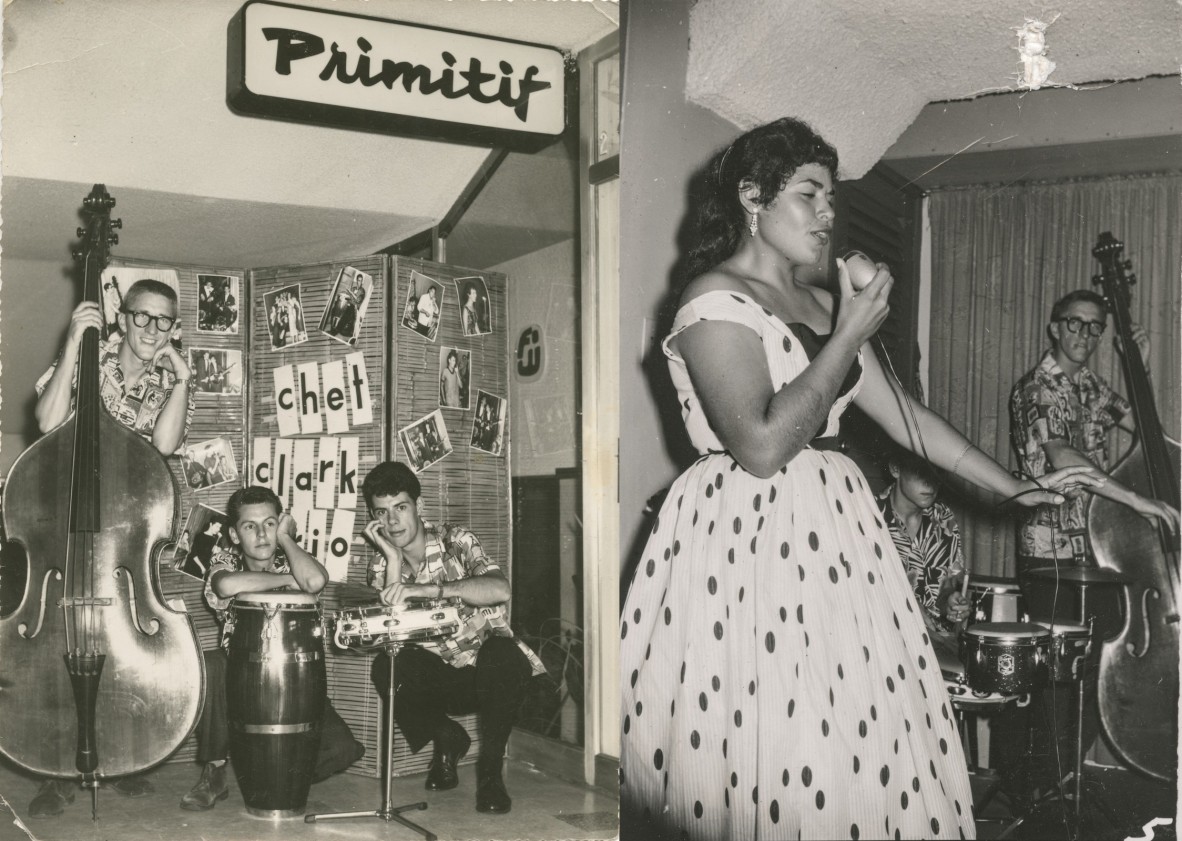
1-Chet Clark Trio at the Primitif Coffee Lounge, Brisbane. Image number 32929-0001-0008
2-Wilma Reading and the Chet Clark Trio at the Primitif Coffee Lounge, Brisbane. Image number 32929-0001-0139.
32929, Peter Hackworth photographs and ephemera, 1955-1965, John Oxley Library, State Library of Queensland
Number 4: Cribb Island
Queensland is full of ghost towns, abandoned settlements and places that are no more but did you know a whole suburb of Brisbane was wiped from the map as recently as the late 1970s?
The suburb of Cribb Island was resumed to expand Brisbane airport. The sleepy little community of 900+ people was depopulated entirely in the late 1970s, the island connected to the mainland for a new runway, and the name Cribb Island was scratched from the maps of Brisbane. Photographer Alexander Love took a day trip to Cribb Island, where he took these wonderful snaps that give some impression of what the suburb was like.
State Library holds maps, photographs, books and manuscript collections that document the existence of Cribb Island before it was lost, explore our collections on our One Search catalogue.
Did you know Cribb Island was also the childhood home of the Gibb brothers, later famously known as the Bee Gees?
2935 Love, Lovf Family collection 1910-1983, John Oxley Library, State Library of Queensland.
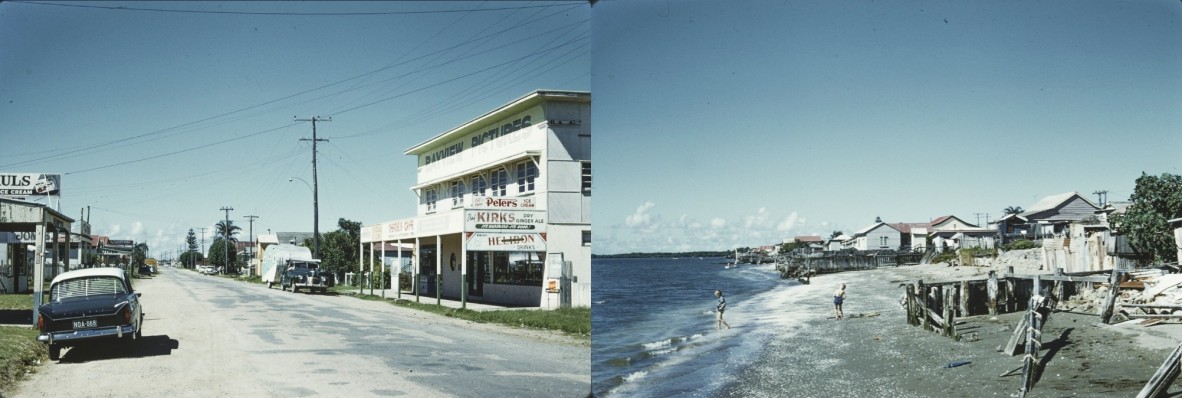
Photographs of Cribb Island. 2935 Love, Lovf Family collection 1910-1983, John Oxley Library, State Library of Queensland.
Number 3: Brisbane Stadium and Festival Hall
Another post sharing the fantastic Love, Lovf Family collection.
When processing this collection, our librarians discovered photographer Alexander Love's diligence in repeatedly returning to certain locations to photograph the progress of new buildings, bridges, landmarks, etc. An excellent example of this is his series of photographs taken of Festival Hall on the corner of Albert and Charlotte Streets. Love initially documents the grand old Brisbane Stadium in 1957, through to its demolition in 1958, to the construction of the shiny new Festival Hall completed in 1959.
Built in 1910, the Brisbane Stadium was mainly used as a boxing and wrestling stadium. Matches were held every Friday night at 7:45pm; however later in its life the venue opened up to live music concerts. Louis Armstrong, Nat King Cole and Johnnie Ray were some of the big names that played there in the 1950s. In 1959 the stadium was replaced with the 4000 seat Festival Hall, which hosted performances for virtually every major tour by visiting overseas artists until its demolition in 2003. The Beatles played two shows on their World Tour in June 1964 and Queen played their last concert of the A Night at the Opera Tour there on 23 April 1976.
2935 Love, Lovf Family collection 1910-1983, John Oxley Library, State Library of Queensland.
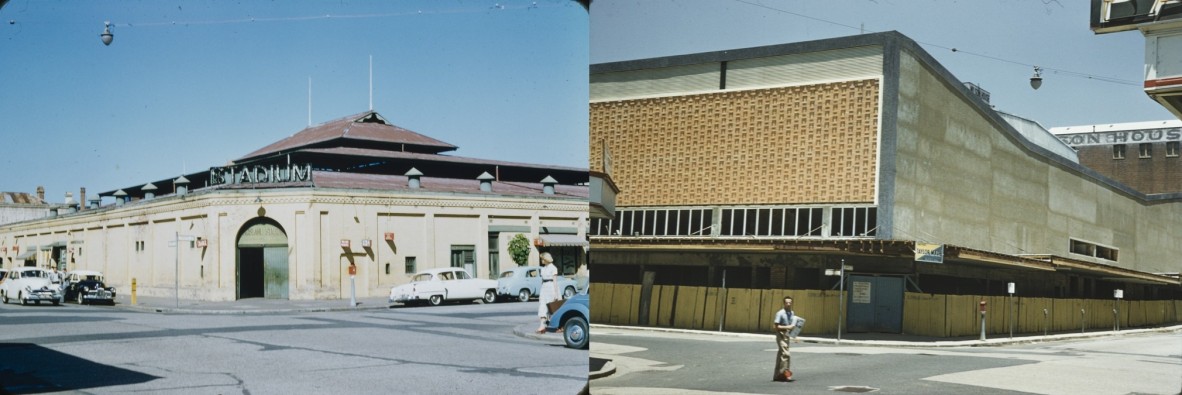
1 Brisbane Stadium, on the corner of Charlotte and Albert Streets, Brisbane, 1957.
2 New Festival Hall, 1959.
2935 Love, Lovf Family collection 1910-1983, John Oxley Library, State Library of Queensland.
Number 2: Photographs of West End by Zhan Teh
State Library's role is to collect material that documents today for tomorrow. A good example of this is a new collection of 120 colour photographs taken in 2020-2021 by photographer Zhan Teh on the streets of West End, Brisbane.
In his spare time, Zhan Teh regularly strolls around West End with his analogue camera taking photographs of the everyday goings on in Boundary Street and the adjacent areas. Over the last couple of years he has accumulated quite of body of work which captures a slice of life in one of Brisbane's well-known suburbs, as well as plenty of West End identities. Zhan donated a selection of his West End photographs to our John Oxley Library collection, and these are now live to view on our One Search catalogue.
With the demographics changing in our inner city suburbs, this collection will document West End's bohemian vibes and colourful characters for future generations to reflect upon.
33401 West End, Brisbane photographs, John Oxley Library, State Library of Queensland.
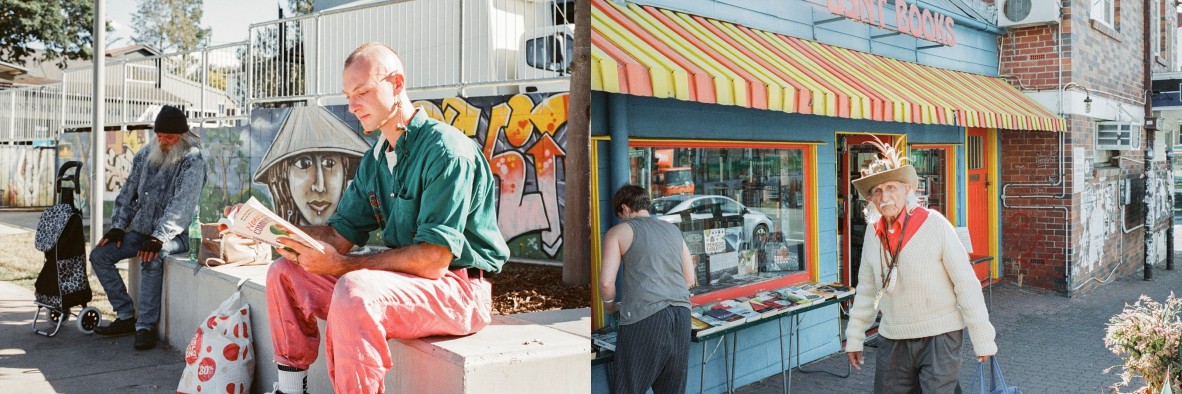
1 Two West End residents sitting on a wall in Boundary Street, West End, Brisbane, August 2020.
2 Man wearing a hat decorated with feathers walking past Bent Books bookshop in West End, Brisbane, 2020.
33401 West End, Brisbane photographs, Zhan Teh, John Oxley Library, State Library of Queensland.
Number 1: The most liked John Oxley Library related post from State Library's Instagram in 2022 is... 40th Anniversary of the demolition of Cloudland.
The 7th November 1982 marked the 40th anniversary of the demolition of Cloudland. At 4am that morning the Deen Brothers undertook what has arguably become the most controversial Brisbane demolition project in the last century. Despite its listing by the National Trust of Australia, public calls for preservation, and a lack of official permits, the original Cloudland Ballroom was erased from the city skyline. This demolition marked the end of over 40 years of dances, debutantes, concerts and even exams held within the colonnades of Cloudland, and the destruction of a much-beloved Queensland landmark.
Cloudland is remembered for its lively programme of old-style and new popular styles of music, supplied by both local and international acts. With its iconic art-deco inspired music podiums and distinctive semi-circle archway, the bandstand was frequently graced by some of the largest names in entertainment.
In the 1950s, it played host to the likes of Buddy Holly; in the 1960s, the Bee Gees brought audiences to rock and bounce on the dancefloors; and throughout the 1970s, Australian talents such as AC/DC, Cold Chisel, Icehouse, Australian Crawl, and the Go Betweens made the stage their home.
Cloudland however would not survive the Bjelke-Peterson era of Queensland politics. Despite numerous calls to preserve the ageing ballroom, the building was deemed a hazard and wiped from existence to make way for apartment buildings.
Though the rubble has long since been cleared, the sadness and betrayal felt by the generations who lived, laughed, and danced their nights away on its signature soft-wooded floors still clings to this day. That's why it's essential that collecting institutions like the John Oxley Library document the history and stories of significant community venues like Cloudland.
You can learn more about the history of Cloudland in our blog: Remembering Remembering Cloudland: 40 years since the demolition of a Brisbane performing arts icon.
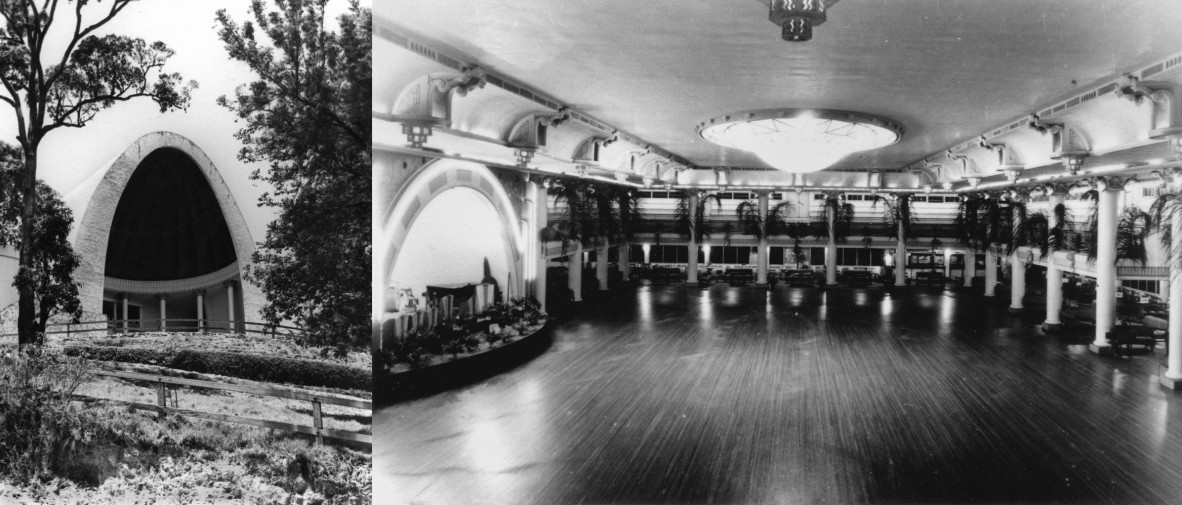
1 Entrance to the Cloudland Ballroom, Bowen Hills, Brisbane, 1946. Neg 61681.
2 Interior view of Cloudland ballroom, Bowen Hills, ca. 1950. Neg 83083.
John Oxley Library, State Library of Queensland.
Comments
Your email address will not be published.
We welcome relevant, respectful comments.